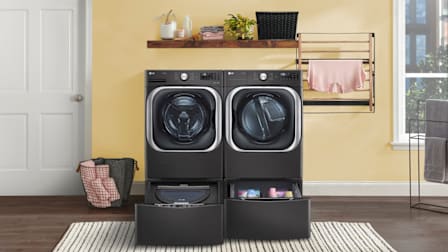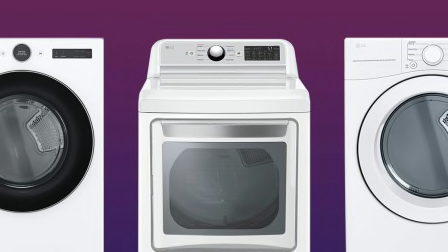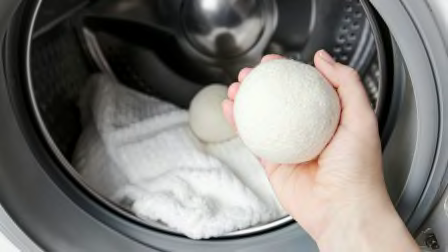Should You Repair or Replace Your Broken Clothes Dryer?
CR’s interactive tool leverages product costs, depreciation rates, and survey data to help you make the right choice
When you shop through retailer links on our site, we may earn affiliate commissions. 100% of the fees we collect are used to support our nonprofit mission. Learn more.

Dryers are relatively simple machines. They have fewer parts than washers and generally chug along for a decade or so. But they still break down sometimes. Our 2023 survey data—reflecting the experiences of 52,374 dryer owners—shows that an array of problems can occur. The most common complaint (at 12 percent) was that the dryer simply wasn’t drying.
In cases where it breaks down, your first reaction may be to repair the dryer. But not every problem can be fixed, and not all fixable situations make economic sense. In our interactive repair or replace tool below, we leverage our survey data to help you determine the best course of action, using the dryer’s age, type, original cost, and potential repair cost. We also share tips on the next steps to take, from finding a dependable repair person to tracking down a new replacement that will stand the test of time.
Factors to Consider
When deciding whether to replace your dryer, don’t consider the repair cost on its own. Think about how the repair cost compares to the original cost. In general, costlier dryers are worth repairing for a longer period of time because the cost of a typical repair is a smaller proportion of the machine’s value. You can find the median repair cost in our interactive tool, depending on your machine’s age and type.
For example, if you spent $600 on your electric dryer nine years ago and you’re pushing it to the limit (say, seven loads per week), a new dryer purchase may be worth it. Shouldering the median repair cost of $133 makes little financial sense in this case. You’re better off flipping that money for a new dryer with excellent reliability and Energy Star certification because it will have a longer shelf life and save energy costs with each load. But if you’ve owned the Speed Queen DF7004WE for three years, $2,200, a repair that costs $215 is probably a worthy investment.
Of course, if your machine is under warranty (as is typical within a year of purchase), it makes sense to simply repair it.
Even if your warranty has lapsed, take a minute to look up your model on the manufacturer’s website. That way, you can check to see if the problem is related to a recall and therefore covered for parts and service or a replacement. Smart dryers may even provide self-diagnostics and maintenance alerts or allow manufacturers to send remote patch fixes for your dryer.
How to Fix Your Dryer: DIY or Hire a Pro?
Most dryer problems require a technician, but a few can be fixed on your own. For instance, if you notice your dryer’s performance is lagging and clothes are taking longer to dry, check to make sure there’s no lint buildup. “Anyone can clean the lint screen and check the external ducting to ensure proper airflow,” says Dean Landers, president of Landers Appliance, a certified service center in Baltimore. If the external ducts are made out of vinyl or foil, they should be replaced with metal flex or rigid ones.
Appliances and Electronics Should be Easy to Fix—Not Just Thrown Away!
In our 2022 survey, 69 percent of CR members sought to repair their dryer when it broke down. Of those who turned to professionals for repairs, 60 percent paid out of pocket, 27 percent were at least partly covered by an original manufacturer’s warranty, and 13 percent were at least partly covered by an extended warranty.
The median repair cost was $149 for a lower-priced gas dryer (under $800) and $192 for a mid- or higher-priced gas dryer (over $800). For electric dryers, the median repair cost was $133 for lower-priced machines (under $700), $173 for midpriced ones ($700 to $900), and $215 for higher-priced models (over $900).
Here’s some good news: 92 percent of all dryers purchased since 2012 are still in use. This raises the question of whether you should you even buy an extended warranty. For a vast majority of CR members, the answer was no. Only 16 percent of respondents purchased an extended warranty or service contract, and 78 percent of them never used it.
Depending on your location, a $120 to $170 service charge is usually added to the total cost, according to Landers. Repairs on large cities and on both coasts may be more expensive, boosting the cost to upward of $275, he says.
Making Greener Choices
• We compiled strategies to save more—and waste less—all around the house.
• Repair vs. Replace: Dishwashers, Microwaves, Refrigerators, Washers.
• See our Appliance Brand Reliability Rankings.
For more, see CR’s Guide to Sustainable Living.
Finding a New Dryer That Will Last
If it turns out that repairing your dryer isn’t worth it, try to find a nearby recycling center at Earth 911 to save it from a landfill. Over 2 million tons of waste, generated by large appliances, ended up in landfills in 2018, according to the Environmental Protection Agency. Replace the old model with one, perhaps an eco-friendly Green Choice dryer, that not only serves your needs now but also avoids breakdowns in the future and ensures a smooth repair process if problems arise anyway.
When you’re ready to shop, start by narrowing your choices to only those that are a good match for your washer. For instance, if your washer doesn’t spin excess moisture from your clothes well, look for a dryer with a standout rating in drying performance. (Check our clothes dryer buying guide to learn more about your options.)
CR members can read on for top-rated models in our clothes dryer ratings. We highlight electric, gas, and compact dryers that are high performers based on CR’s tests and made by reliable dryer brands, according to data from our member surveys. All offer excellent reliability except for the Samsung, which our readers judged to have very good reliability. Some are also Energy Star certified—meaning they use 20 percent less energy than conventional dryers—which will save you money over the long term. About half the electric dryers in our ratings are Energy Star certified.
































